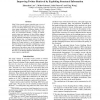Free Online Productivity Tools
i2Speak
i2Symbol
i2OCR
iTex2Img
iWeb2Print
iWeb2Shot
i2Type
iPdf2Split
iPdf2Merge
i2Bopomofo
i2Arabic
i2Style
i2Image
i2PDF
iLatex2Rtf
Sci2ools
AAAI
2012
2012
Improving Twitter Retrieval by Exploiting Structural Information
Most Twitter search systems generally treat a tweet as a plain text when modeling relevance. However, a series of conventions allows users to tweet in structural ways using combination of different blocks of texts. These blocks include plain texts, hashtags, links, mentions, etc. Each block encodes a variety of communicative intent and sequence of these blocks captures changing discourse. Previous work shows that exploiting the structural information can improve the structured document (e.g., web pages) retrieval. In this paper we utilize the structure of tweets, induced by these blocks, for Twitter retrieval. A set of features, derived from the blocks of text and their combinations, is used into a learning-to-rank scenario. We show that structuring tweets can achieve state-of-the-art performance. Our approach does not rely upon social media features, but when we do add this additional information, performance improves significantly.
| Added | 29 Sep 2012 |
| Updated | 29 Sep 2012 |
| Type | Journal |
| Year | 2012 |
| Where | AAAI |
| Authors | Zhunchen Luo, Miles Osborne, Sasa Petrovic, Ting Wang |
Comments (0)

